
|
The
Adventures of
the
Red Shadow
South
of the Sahara
Continued........
|
|
 THE
SCENARIO AND RULES THE
SCENARIO AND RULES
| French
West Africa 1912
THE
RULES
As always,
the game was played by using the brilliant set of rules The Sword and the
Flame (TSATF). We use a slightly modified version of this system.
The main digression
from the origianl system we use is to
-
split wounded
into two types - walking and operating wounded and incapacitated wounded.
If you have the newest set of these rules, it is my understanding that
they have adopted this method.
-
use our own specific
firing table, which is reproduced below.
-
double firing
range to 48" (with half figures firing).
-
removed the "pinned
morale" rule and replace it with the "shaken morale" instead (units which
fail to charge home).
|
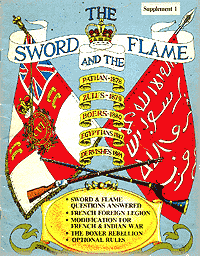 |
| The rest of the rules
are used as is. We do use the modifications as given for the French Foreign
Legion and apply same changes to teh Colonial Marines. The Tukulor are
treated as "Arabs or Berbers" from the FFL supplement. |
Firing Table
This is the firing chart used in
our games. The main modification is that firing at hald figures is allowed
out to double range, and that magazine fed rifles can fire twice . This
is a necessary modification to bring the game results into line with authentic
casualty rates when units with modern smoleless magazine fed rifles are
in conflict with muskets or single shot breechloading black powder weapons
(the type of rifle the game was originaly designed to factor). |
|
Firing Table
1D20 per Figure
|
| |
Target
Type
|
| Firing
Unit |
Range
Horse
Camel
|
Close
Order
|
Open
order / Mtd
|
Soft
cover
|
Hard
cover |
| Pistol
(fires 2D ½ range, 4D on charge, 1D double range) |
8
|
1-3
|
1-2
|
1
|
1/2
|
| Superior
Rifle |
24(18h/12c)
|
1-7
|
1-6
|
1-5
|
1-4
|
| Regular
Rifle |
24(18h/12c)
|
1-6
|
1-5
|
1-4
|
1-3
|
| Inferior
Rifle |
24(18h/12c)
|
1-5
|
1-4
|
1-3
|
1-2
|
| Poor
Rifle |
18(12h/12c)
|
1-4
|
1-3
|
1-2
|
1
|
Musket
(½
may fire) |
18(12h/12c)
|
1-4
|
1-3
|
1-2
|
1
|
| |
|
|
|
|
|
| Hotchkiss
1899 MG |
18/36-24
|
1-8/1-7
|
1-7/1-6
|
1-6/1-5
|
1-5/1-4
|
| St.
Etienne 1907 MG or Maxim MG |
18/40-24
|
1-9/1-8
|
1-8/1-7
|
1-7/1-6
|
1-6/1-5
|
| |
|
|
|
|
|
| French
75mm -canister |
24/48-12
|
1-6/1-5
|
1-5/1-4
|
1-4/1-3
|
1-3/1-2
|
French
8cm
-canister |
20/40-10
|
1-5/1-4
|
1-4/1-3
|
1-3/1-2
|
1-2/1
|
| |
|
|
|
|
|
| Native
Mtd Spear |
4
|
1-3
|
1-2
|
1
|
1/2
|
1. All
rifles and MGs may fire half figures at double range-rounded down.
2. Box Magazine and
clip fed Rifles (eg. Lee and Mauser) may fire twice at normal range.
3. Tubular Magazines
Rifles (eg. French Lebel) may fire twice on a Charge
4. Wounded add +2
to dice roll (unmodified 1s always hit)
5. MGs require 2
figures to operate otherwise 1/2 dice thrown
6. MGs and Guns throw
dice
as shown after range listing
7. Native capture
MGs Jam if roll includes a 20 (Throw less dice avoid jam)
8. Incapacitated and
routed figures may not fire.
9. Friendlies in fire
arc are hit by Key Figure hits
10. Mounted Irregulars
may fire half figures in a charge, no others may fire while charging.
11.All mounted fire
with a +1 modifier to the die roll |
| You will notice that we use the
terms Superior down to Poor for the firing units. This should be considered
relative terms to be set by the scenario designer. For example, a Legion
unit with Lebel rifles could be considered superior, whereas hastily raised
native troops with the same weapon could be considered regular or even
inferior. However, most French raised natives were well armed and trained
(unlike some other European native armies and should usually be considered
regular).
Most native armies, such as Arabs,
Berbers and Tukulor were armed with "inferior" weapons although some units
within the Tukulor army propper should be considered regular and Samori's
bodyguard is Superior, with magazine fed Krapotchek rifles..
Modern machineguns were and are devestating
and should be used very sparingly or start "packed" on a mule in an ambush
scenario to give the natives any chasnce of prevailing. - unless you have
an unlimited supply of native figures for the scenario.
We use a purpose built "hit pack"
rahter than the playing card system, consisting of the following.
| TYPE |
NUMBER
|
| Leader Killed |
1
|
| Leader Incapacitated |
1
|
| Leader Wounded |
1
|
| Leader Grazed (no
effect) |
2
|
| Key Figure Killed |
3
|
| Key Figure Incapacitated |
3
|
| Key Figure Wounded |
3
|
| Other Figure Killed |
12
|
| Other Figure Incapacitated |
12
|
| Other Figure Wounded |
12
|
|
|
|
Shown below are some Images
from the Niger region of Mali.
The area presented in this game.
Select the image for a larger
picture.
These images are from 1906 -
1907
|
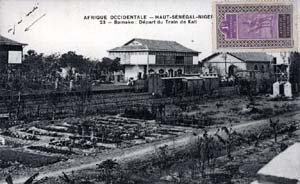
|
|
The
French Railroad of the Niger Region
|
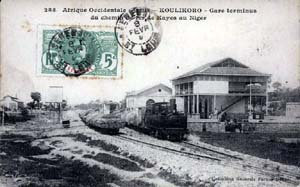
|
|
The
Railway in Operation
|
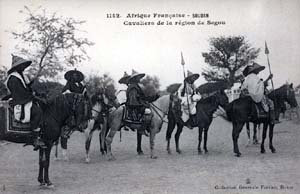
|
|
Native
Warriors from the Segu Region
|
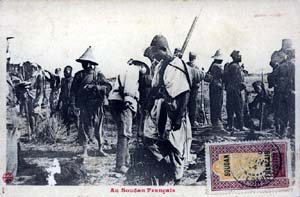
|
|
Tirailleurs
fromSoudan, Officers and Natives
|
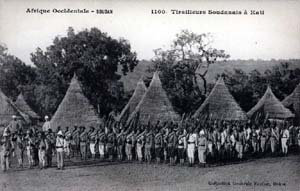
|
|
Tirailleurs
on Parade
|
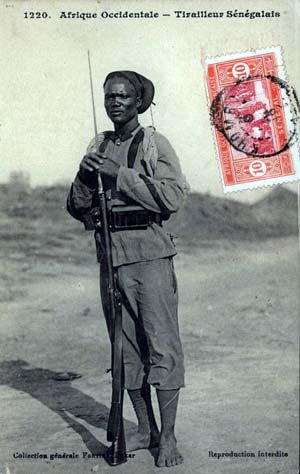
|
|
Senegalese
Tirailleur, the mainstay of French Military Power in the Sudan.
|
|
| The cast for this scenario was set
as follows
French Forces all
rifles are regular - unless noted. |
-
French Commander
-
Tirailleur Senegalasie - 10 men in fort with French officer.
-
Tirailleurs Senegalaise - 10 men plus African sergant. On patrol in town.
-
French Engineers - 6 men - 2 officers, pilot and navigator
in redoubt.
-
Train - Engineer, Fireman, Break man, Train Guard - all armed with pistols
(inferior) in train
-
Train Gun. 75mm field gun. 2 crew.
-
Passengers - 3 armed with rifles (inferior) 3 unarmed - including two women,
at station.
-
Marines - 10 men,1 segeant, 1 MG crew split into two smaller boats, each
with two sailor crewmen including 1 sergant
-
Marines - 10 men and 1 officer on larger boat. Boaat armed with 75mm filed
pice. 8 sailor crew and one sailor officer.
|
-
Ahmadou - Tukulor commander
-
Mounted Sofas - 15 men, inferior rifles
- 1 leader.
-
Mounted Sofas - 15 men, inferior rifles
- 1 leader.
-
Mounted Sofas - 15 men, inferior rifles
- 1 leader.
-
Camel mounted Sofas - 12 men - 1 leader
-
Sofas, , infantry - 20 men inferior
rifles, 1 leader
-
Sofas, , infantry - 20 men inferior
rifles, 1 leader
-
Sofas, , infantry - 20 men inferior
rifles, 1 leader
-
Sofas, , infantry - 20 men swords, 1
leader
-
Sofas, , infantry - 20 men swords, 1
leader
-
Sofas, , infantry - 20 men swords, 1
leader
|
Notes and Specials
There is a Bambara camel train passing
through the town consisting of 10 camels and 10 native tradesmen armed
with muskets. The are controlled by the umpire until safely off the board
in the middle of the town, or until attacked by either side in which
case their control is handed to the side that didnt attack them. They begin
by passing in front of the train to get to the center of the town then
exit through the town. |
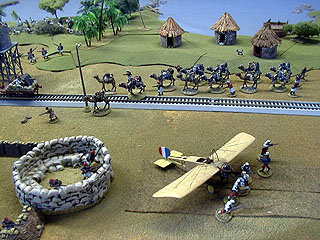 |
| Bambara Camel Train heading into
town. |
|
There is also
a unit of 12 Chasseurs, including a sergeant and an officer and 3 scouts,
including the red shadow. They return on D6 turns after the first gunfire.
The train may accelerate +4 or 2
per turn. So if it accelerate 4 in the turn, it automatically moves 4
as soon as its card is drawn and may then accelerate another 4 ore reduce
by 2. On the next turn it will then either move 8 or 2 depending whether
it accelerated or decelerated.
If the train is left without a crew
and is moving, it will derail on a bend if its speed is more than 8 on
a D6 die roll of 4-6. |
| The aircraft needs a full turn with
someone standing by the prop and a crew in the cockpit doing nothing
else. It starts on a D6 roll of 1-5. It must spend an entire turn warming
up; otherwise, the engine seizes on a roll of 4-6 on the first turn it
starts to move.
It must accelerate 18 on its first
turn to take off, the next turn it leaves the board. It may return on the
next turn but one and move 36". It may them turn up to 45 degrees at the
end of its move. When it leaves the table, it must be off an entire turn
before it can return.
Any horse under the aircraft scatter
in random directions 2D6 inches on a D6 roll of 4-6. The navigator may
fire at selected targets and hits on a D20 roll of 1.
The three rifle units may start in
ambush, as per the main rules. Their set up points are in the thicket either
side of the hut village and to the east of the port in the thicket there.
The sword and mounted units may enter in either end of the table east
and west. On their first turn of entry they are placed at the edge of the
board, and measured on from the next turn. |
|


![]() THE
SCENARIO AND RULES
THE
SCENARIO AND RULES![]()








